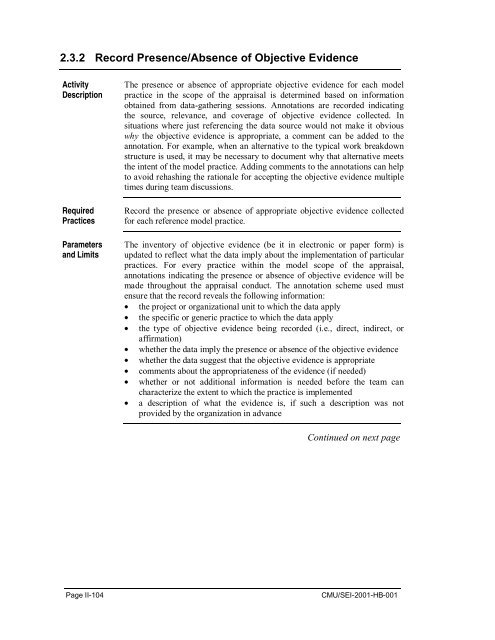Standard CMMI Appraisal Method for Process Improvement (SCAMPI)
Standard CMMI Appraisal Method for Process Improvement (SCAMPI)
Standard CMMI Appraisal Method for Process Improvement (SCAMPI)
You also want an ePaper? Increase the reach of your titles
YUMPU automatically turns print PDFs into web optimized ePapers that Google loves.
2.3.2 Record Presence/Absence of Objective Evidence<br />
Activity<br />
Description<br />
Required<br />
Practices<br />
Parameters<br />
and Limits<br />
The presence or absence of appropriate objective evidence <strong>for</strong> each model<br />
practice in the scope of the appraisal is determined based on in<strong>for</strong>mation<br />
obtained from data-gathering sessions. Annotations are recorded indicating<br />
the source, relevance, and coverage of objective evidence collected. In<br />
situations where just referencing the data source would not make it obvious<br />
why the objective evidence is appropriate, a comment can be added to the<br />
annotation. For example, when an alternative to the typical work breakdown<br />
structure is used, it may be necessary to document why that alternative meets<br />
the intent of the model practice. Adding comments to the annotations can help<br />
to avoid rehashing the rationale <strong>for</strong> accepting the objective evidence multiple<br />
times during team discussions.<br />
Record the presence or absence of appropriate objective evidence collected<br />
<strong>for</strong> each reference model practice.<br />
The inventory of objective evidence (be it in electronic or paper <strong>for</strong>m) is<br />
updated to reflect what the data imply about the implementation of particular<br />
practices. For every practice within the model scope of the appraisal,<br />
annotations indicating the presence or absence of objective evidence will be<br />
made throughout the appraisal conduct. The annotation scheme used must<br />
ensure that the record reveals the following in<strong>for</strong>mation:<br />
• the project or organizational unit to which the data apply<br />
• the specific or generic practice to which the data apply<br />
• the type of objective evidence being recorded (i.e., direct, indirect, or<br />
affirmation)<br />
• whether the data imply the presence or absence of the objective evidence<br />
• whether the data suggest that the objective evidence is appropriate<br />
• comments about the appropriateness of the evidence (if needed)<br />
• whether or not additional in<strong>for</strong>mation is needed be<strong>for</strong>e the team can<br />
characterize the extent to which the practice is implemented<br />
• a description of what the evidence is, if such a description was not<br />
provided by the organization in advance<br />
Continued on next page<br />
Page II-104<br />
CMU/SEI-2001-HB-001
















